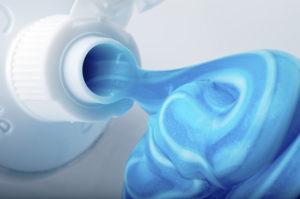 According to the latest research review, triclosan is supposed to be just dandy in toothpaste. Specifically, its authors concluded that
According to the latest research review, triclosan is supposed to be just dandy in toothpaste. Specifically, its authors concluded that
regular use of fluoride toothpaste containing triclosan, an antibacterial agent, and a copolymer, which helps prevent the triclosan from being washed away by saliva, reduces plaque, gingivitis and bleeding gums and slightly reduces tooth decay compared with fluoride toothpaste without those ingredients.
That conclusion isn’t nearly so great as it might sound. For one, the improvements were only modest. But more, coming at it from a holistic, biological viewpoint, you see two red flags flying high.
The first, of course, is “fluoride” – and you already know what we think about that. (If not, explore our archives.) The second is “triclosan,” which other research has been found to be incredibly detrimental to both human and environmental health. (In fact, such risks led earlier researchers to conclude that triclosan should not be used in toothpaste, as the risks outweighed any potential dental benefit.)
Here’s how triclosan works: Cells of all sorts are surrounded by a wall of fatty acids, and through a very complex variety of chemical locks and keys, they allow nutrients – and all manner of other substances – into the cell. Triclosan essentially kicks in the fatty acid door, leaving the cell and the door damaged.
The cells in your body are chock full of fatty acids too, and fatty acids are big players in the integrity of your endocrine system, which manages just about everything your body does – healing and regeneration, hormone function, immune function, metabolism, central nervous system, everything. Triclosan appears to be a significant endocrine disruptor.
Triclosan also wreaks havoc on microorganisms that live in the soil, the waterways and the oceans – organisms that everything alive on this planet relies on to live, eat, poop, breed and die, providing food for bigger organisms and chemical byproducts that are critical for the planet’s natural recycling system.
 Over time, daily ingestion of triclosan via toothpastes, mouthwashes or the vast array of other products it’s in becomes an onslaught. The chemical does what it does. It doesn’t know the difference between the organism it’s meant to protect from the one it’s there to eradicate.
Over time, daily ingestion of triclosan via toothpastes, mouthwashes or the vast array of other products it’s in becomes an onslaught. The chemical does what it does. It doesn’t know the difference between the organism it’s meant to protect from the one it’s there to eradicate.
A 2008 study found that 75% of Americans have remnants of triclosan in their system, appearing in urine, blood and breast milk samples.
The FDA says it has been studying triclosan since the 1970s, just after it was introduced to the market – believe it or don’t – as a pesticide. Independent environmental studies have shown that high doses of triclosan negatively affect growth and reproduction of some fish species. While there are those who challenge these results, cite the old adage “dose makes the poison”: The dose we are dumping into the environment by the overuse of triclosan in everyday life could get pretty high.
Oh, and it does appear to be bioaccumulative, building up in the body over time – even in people who don’t use products containing triclosan.
Understandably – and fortunately – some folks have had enough. Recently, the state of Minnesota banned the sale of products containing triclosan, pressuring manufacturers to bend to consumer will and remove the chemical from all products by 2017.
And slowly but surely, they actually have been. The largest national manufacturers and distributors of body care products such as Johnson & Johnson and Proctor and Gamble have already begun phasing it out, all the while making claims that it is perfectly safe. But they know that business is business, and if you want to sell products, you listen to your customers. Public awareness is fueling change in manufacturing processes and hopefully, will lead to healthier, more biocompatible products.
Images by Nick Harris & Finishing School, via Flickr